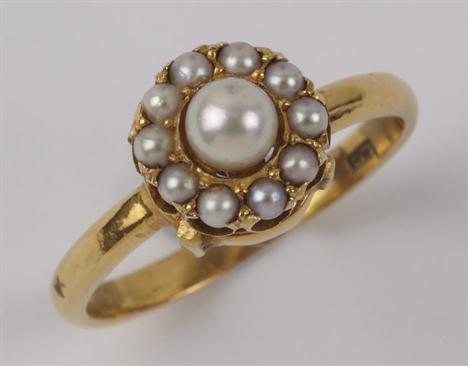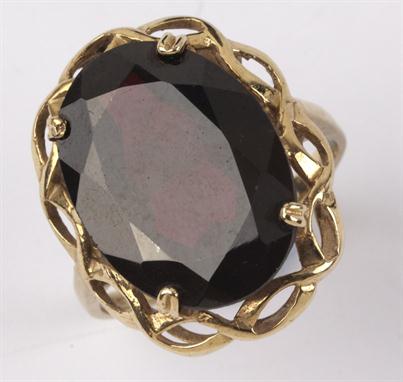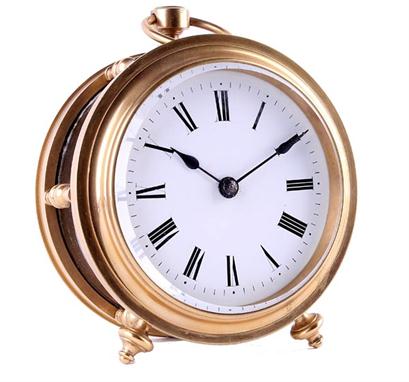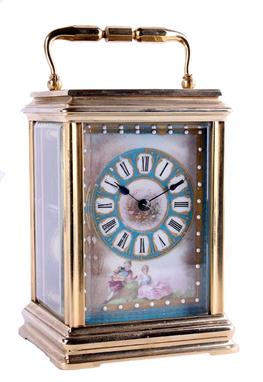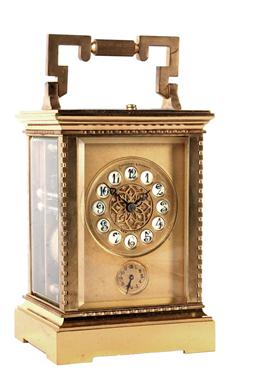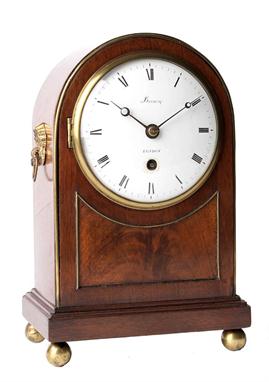We found 1087811 price guide item(s) matching your search
There are 1087811 lots that match your search criteria. Subscribe now to get instant access to the full price guide service.
Click here to subscribe- List
- Grid
-
1087811 item(s)/page
Ladies` diamond set ring, comprising centre row of nine marquise cut stones graduating in size, eleven small brilliant cut diamonds in milli-grain settings to either side, total weight of diamonds approx. 0.40 carats, all in white gold, 18ct h/m, size M or 6 US (5.2g)
Ladies` vintage diamond set cocktail ring, comprising oval stone to centre with fan to one side set with four tapered baguette cut stones, wave to other side set with two brilliant cut stones, twist wave below set with fifteen baguette cut stones, total diamond weight approx. 0.50 carats, ornate pierced under-bezel, all in yellow gold, tested 18ct, size Q or 8 US (4.2g)
Ladies` diamond solitaire ring, comprising old cut stone, approx. 0.65 carats, small chip to side of stone, in eight claw crown setting, two small diamonds set in shoulders, stamped & tested platinum, size P or 7.1/2 US (3.2g) original ivory coloured bakelite box
Ladies` antique cluster ring, comprising marquise shaped front set with a round cut mid-blue sapphire to centre with smaller stone above & below, surround of sixteen old cut diamonds, total weight approx. 0.30 carats, split shoulders, 18ct gold h/m Birmingham 1900, size M or 6 US (3.0g) original ivory coloured bakelite box
Ladies` three stone diamond ring, comprising early brilliant cut stones, centre stone approx. 0.80 carats, side stones each weigh approx. 0.75 carats, each stone in crown setting, 2.30 carats in total, all in white metal, tested platinum, size P or 7.1/7 US (3.6g) original leather ring case
Various ladies` silver bracelets, comprising three bar gate bracelet, fitted with bolt ring fastener, padlock fitted to one end, heart shaped link bracelet, links connect to each other to fasten, brick link bracelet fitted with trigger fastener & an oval belcher link bracelet fitted with T-bar & large bolt ring fastener, plain heart fitted to one end, stamped, tested or h/m (2.04oz) (4)
Various silver items, comprising ladies` hinged bangle, approx. 12mm wide, with complete floral pattern, fitted with snap fastener & safety chain, cameo pendant & ring to match, Thai silver brooch, paua shell set brooch, gent`s goldstone set ring, ladies` ring set with multiple white stones & a Victorian diamond jubilee pendant, stamped, tested or h/m (2.05oz) (8)
Various silver items, comprising ladies` hinged bangle, approx. 10mm wide, ornate pattern to one half, fitted with snap fastener & safety chain, stylish bow brooch, small cross pendant complete with trace chain, fitted with barrel fastener, ladies` stone set rings (5), inc. amber, agate, marcasite etc., patterned bands (2) & a dolphin ring, stamped, tested or h/m (2.05oz) (11)
Ladies` silver bracelets, comprising antique curb link bracelet, approx. 7”, fitted with silver fastener, requires jump ring, complete with fourteen groat coins of various monarchs from Charles II 1682 through to young Victoria 1871, coins all holed, ladies fancy bracelet complete with three charms, another fancy bracelet & a child`s micro-belcher bracelet, complete with two small charms, stamped or tested (2.03oz) (4)
Silver modernist dish with six holes to centre, each about 0.5” deep, possibly an epergne centre with flutes/trumpets missing, dish approx. 5” diameter, designed by Gerald Benny for Viners, h/m Sheffield 1962, base weighted & a silver ring holder in shape of three leaf clover with a tree in centre, approx. 3.5” wide x 3” tall, h/m Birmingham, both have some wear (2)
Jaeger Le Coultre Atmos Clock, “working” order, circa 1965, approx. 9.75” tall, comprising gilt brass metal case with glazed side panels, front glazed door has small handle, fluted green & gilt corner columns, white chapter ring with black Roman numerals inscribed `Swiss Made`, black moon hands, skeletonised dial centre, with a large oscillating wheel below, on a green marble base, good condition
Two ornate ormolu mantle clocks, with figures of huntsmen, one on wooden plinth, both approx. 12.5” tall, & a large French style gilt metal mantle clock with top acorn finial, lions head handles, enamelled chapter ring, approx. 18” tall, don`t appear to be working, reproductions, in poor condition, some damage (3) Care! High International Shipping Charges
WWI Medals & misc., inc. British War Medal & Victory Medal, awarded to M2-204253 Pte E Bradshaw ASC, with some Bury Athletic Club silver fobs (6), Army Football Club silver fobs, engraved `Vice Captain, E Bradshaw, 1917-18` on reverse (2), a 1941 Padiham U.D.C. Chairman`s silver & enamelled coat of arms badge, a Kings Own cap badge & a signet ring inscribed `Tripoli`, stamped 800, medals good very fine, slight discolouring on Victory Medal, toning on War Medal (approx. 4oz silver) (13 items)
A rare James I brass sundial. Inscribed John Robins, dated 1619. The 8.75 inch octagonal plate fitted with scroll decorated angled gnomen set at 51 degrees and centred with a thirty-two point compass rose with stylised sunburst and billowing cloud engraved decoration to segments and annotated NE, SE, SW and NE within the inner track, the middle track engraved N, E, S and W and inscribed Iohn Robins between N and E, the narrow outer track with Roman numeral chapters IIII-XII-VIII divided into quarter-hours as well as eighths, with floating asterisk half hour markers and engraved Anno Cristi *1619* between IIII and VIII, the angles with line engraved border panels and holes drilled for fixing. The engraved detail, octagonal shape and the profile of the original gnomen of the current lot closely conforms to features seen on three related sundials by William Bowyer, Richard Hinton and Isaac Symmes illustrated and discussed in White, George NOT A BAD TIMEKEEPER: THE ENGLISH LANTERN CLOCK IN THE SEVENTEENTH CENTURY (Antiquarian Horology Vol. 31 Sept. 2009 pages 624-8). Indeed the engraved N, E, S and W lettering is so close to those on the Hinton and Symmes dials that it would perhaps be reasonable to suggest that these three dials were engraved by the same hand. The narrow chapter ring, with its asterisk half-hour markers, also closely conforms with those of Bowyer and Hinton Dials and can be compared with the chapter rings applied to the earliest English domestic clocks such as Francis Nowe’s chamber clock of 1588 and the earliest ‘First Period’ lantern clocks made in the Harvey workshops (prior to 1620). The striking similarities between the current lot and the Hinton, Bowyer and Symmes dials is such that it is possible that they were all made for the same purpose in neighbouring workshops. As White suggests that these examples were made by clockmakers to be supplied alongside lantern clocks then it would perhaps be reasonable to suggest that the current lot was also possibly made by a clockmaker for the same purpose. If this is the case then a date of 1619 would place this dial amongst the products of a maker producing some of the earliest lantern clocks. The engraved name ‘Iohn Robins’ has clearly been added by a different hand than the maker of the dial -as indicated by style of the text with its hatched stems and very positioning on the dial. The style of the font (in particular the ‘s’ of ‘Robins’) suggests that this name was added soon after the dial was made and is probably more likely to be the name of the original owner rather than the maker. It is perhaps interesting to note that records indicate that a John Robins bought a farmhouse known as ‘Boddenhams’ from the Manor of Upton St. Leonards, near Gloucester in 1619. This location would certainly be close enough to the latitude 51 degrees North to allow the current lot to give reasonably accurate readings. Please note: The estimate in the printed catalogue is incorrect
An unusual plated brass cylindrical timepiece with alarm. Carter, London, late 19th century. The circular four finned-pillar spring barrel movement with five-spoke wheel crossings and lever escapement set between the centre pair of plates and sprung monometallic balance aligned within a circular aperture to the backplate, the rear of the movement with further movement blanking plate cut with Slow/Fast regulation sector, with threaded going and alarm winding keys, knurled hand and alarm setting turns, alarm hammer sounding on the interior of the case and engraved No. 347 to the spotted rear surface, the 2 inch circular gilt Roman numeral dial with alarm setting hand applied to the flush rotating disc centre within chapter ring with outer minute track and signed CARTER, 61 CORNHILL at XII, with blued steel spade hands, the plain cylindrical case with canted bezel behind convex glass and threaded rear cover with knurled edge, 6.5cm (2.5ins) diameter. John Carter is recorded in Baillie G.H. Watchmakers & Clockmakers of the World as apprenticed in 1817 and gaining his freedom of the Clockmakers’ Company in 1829. He was an accomplished chronometer maker who won numerous awards at the 1838 chronometer trials; by 1840 he had set up business in 61 Cornhill. In 1855 Carter and held the position of juror at the Imperial Exhibition held in Paris and was appointed Master of the Worshipful Company of Clockmakers three times (in 1856, 59, and 64). As well as being a highly skilled horologist John Carter was also notable as a civic activist -perhaps due to his experiences as a child as he was orphaned at an early age. His charitable nature lead him to be elected Lord Mayor in 1859, he died 1878. The current lot is noteworthy in that a great deal of thought seems to have gone into its layout and finish. The construction of the movement with the dial, movement and rear blanking plates forming a compact three-tier frame into which the wheelwork has been carefully arranged, this coupled with details such as five-spoke wheel crossings, integral sprung ratchets and finely turned pillars demonstrates an individual high quality approach.
A French champlevé enamelled brass combination carriage timepiece with barometer, thermometer and compass. Unsigned, late 19th century. The eight-day single train movement with silvered platform lever escapement and circular silvered Roman numeral chapter ring within a rectangular bird inhabited foliate scroll engraved cobalt blue ground enamelled gilt brass mask, set beside a conforming aneroid barometer with silvered register calibrated in barometric inches and the usual observations within a matching surround and with Fahrenheit scale mercury thermometer between, the bevel-glazed case with elaborate turned and fluted baton ‘T’ shaped handle above circular convex glazed escapement and compass apertures to top and blue enamel ground floral engraved frieze and matching apron panels divided by turned and fluted pilasters projecting at the angles, on turned tapered feet, 15cm (6ins) high; with a faux leather covered protective outer case.
A French gilt brass grande sonnerie striking carriage clock with push-button repeat and alarm. Unsigned, circa 1900. The eight-day two train movement striking the hours followed by the quarters on a pair of gongs every quarter of an hour, with original silvered platform lever escapement and numbered 1865 to backplate, the dial with white enamel Arabic numeral chapter ring set into an elaborate gilt foliate chased blind fret decorated rectangular mask incorporating conforming subsidiary alarm setting dial to lower margin, the gilt pillars bevel glazed case with hinged carrying handle above moulded cornice and fluted three quarter column uprights to angles, on conforming moulded base with squab feet, the underside with Grande Sonnerie, Petite Sonnerie and Silence selection lever, 15cm (6ins) high excluding handle; with original leather covered outer travelling case.
A French gilt brass carriage timepiece with alarm. Unsigned, circa 1900 .The eight-day movement with silvered platform lever escapement and alarm sounding on a bell mounted within the base of the case, with circular white enamel Arabic numeral chapter ring set into a rectangular gilt mask overlaid with foliate scroll engraved and pierced fretwork and incorporating a conforming subsidiary alarm setting dial to lower margin, the case with turned hinged carrying handle above cast filigree overlaid frieze and projecting curved corners forming the caps and basis of reeded baluster turned corner columns, the base with conforming filigree decoration to apron and on turned feet, 12.5cm (5ins) high excluding handle; with original maroon leather covered outer travelling/display case.
A rare French gilt brass circular fusee carriage timepiece with two-plane lever escapement. R.E.D. Paris, late 19th century. The circular movement with silvered platform for the sprung bimetallic balance and lever with pallets engaging with a vertical escape wheel mounted between the movement plates, the backplate stamped with monogram R.E.D. within circular medallion incorporating BREVETTE, PARIS to circumference and numbered 99F to lower margin, the circular white Roman numeral enamel dial with blued steel spade hands within canted bezel and behind thick bevel glass, the circular case with ring handle above ogee moulded front and rear sections united by six double baluster pillars with cylindrical glass sleeve between, the rear cover with shuttered winding and hand adjustment squares, the base with two turned feet to front, 12.5cm (5.75ins) high excluding ring of handle. An identical example to the current lot is illustrated and described in Allix, Charles and Bonnert, Peter CARRIAGE CLOCKS, Their history and development pages 213-4.
A French gilt brass gorge cased carriage clock with painted porcelain dial. Unsigned, mid to late 19th century. The two train eight-day bell striking movement with original silvered platform lever escapement and numbered 3036 to backplate, the rectangular porcelain dial with floral decorated centre within blue ground gilt bordered Roman numeral cartouche chapter ring above scene painted with a 18th century gentleman serenading a companion within ‘jewelled’ decorative gilt border, the bevel glazed gorge case with hinged carrying handle, 14cm (5,5ins) high excluding handle; with a leather covered outer travelling case.
A gilt brass petit sonnerie striking carriage clock with push-button repeat and alarm. Unsigned, probably late 20th century. The eight-day two train movement striking the quarters on a graduated pair of gongs and sounding the hour and alarm on the larger of the two, with platform lever escapement and rectangular gilt dial with rosette centre within chapter ring applied with Arabic enamel cartouche numerals, bearing a retailer’s signature CAMERDEN & FORSTER, NEW YORK and with alarm setting dial to lower margin, the gilt bevel glazed case with hinged carrying handle above cavetto cornice and repeating block and bead decorated angles to uprights, on conforming skirt base incorporating squat bracket supports, 16.5cm (6.5ins) high excluding handle.
A Victorian brass skeleton timepiece. Unsigned, mid 19th century. The single fusee movement with six-spoke wheel crossings, anchor escapement, rosette decorated pendulum bob and waisted scroll-pierced plates united by four swollen pillars, the dial with shaped outline silvered Roman numeral chapter ring and blued steel hands, on four turned conical feet, the clock, 25.5cm (10ins) high; on moulded rectangular ebonised wood base with turned feet and glass dome cover, 34cm (13.5ins) high overall.
A Victorian brass skeleton timepiece. Unsigned, mid 19th century. The single chain fusee movement with five-spoke wheel crossings, anchor escapement and two tier waisted scroll-pierced plates united by six knopped pillars, the dial with silvered Roman numeral chapter ring and blued steel Breguet moon pattern hands, on four turned bell-shaped feet, the clock 23cm (9ins) high; on walnut stepped ovoid base with glass dome cover, 30.5cm (12ins) high overall.
A Regency small brass mounted bracket timepiece. Brown, London, circa 1820. The four pillar single fusee movement with anchor escapement, unusual Maltese cross stopwork to the spring barrel and arched plates, the 4.5 inch circular white convex enamel Roman numeral dial signed Brown, LONDON to centre and with blued steel Breguet style moon hands within a cast brass convex glazed bezel, the arched case with brass cockbead moulding to the front edges and similar raised moulding to the shaped apron panel, the sides with gilt brass ring handles, on stepped skirt base with brass ball feet, 25.5cm (10ins) high.
A late Victorian brass mounted quarter chiming bracket clock. Unsigned, late 19th century. The four pillar triple chain fusee movement with rise/fall regulation, chiming a choice of two melodies for the quarters on a nest of eight graduated bells and striking the hour on a gong, the 7.5 inch brass break-arch dial with matted centre within applied silvered Roman numeral chapter ring with stylised fleur-de-lys half hour markers and Arabic five minutes to outer track, the angles with foliate festoon and scroll cast spandrels beneath arch applied with subsidiary FAST/SLOW dial above further CHIME/SILENT and WESTMINSTER/CHIME ON EIGHT BELLS selection dials within conforming cast mounts, the bell-top case with basket of flowers and scroll cast mount to upstand and pineapple finials, conforming mounts to upper quadrants of the front door flanked by reeded Corinthian columns to front angles, the sides with rectangular cast brass sound frets decorated with foliate scrolls and Arabesques, on tall moulded base with leaf moulded upper border and lobed feet, 59cm (23ins) high excluding later top finial.
A French malachite inset Belge noir marble perpetual calendar mantel clock with moonphase. Henry Marc, Paris, Late 19th century. The eight-day bell striking movement stamped with oval trademark H’Y MARC, PARIS and numbered 50133 to backplate, the two piece white enamel Roman numeral dial with visible Brocot escapement to the recessed centre, regulation square at twelve o’clock and blued steel Breguet style moon hands within a bevel glazed cast brass bezel, set above a conforming two-piece calendar dial with day of the week and date of the month subsidiary dials flanking cloud painted moonphase aperture to the recessed centre, the outer ring annotated with the months and the equation of time to inner edge within conforming glazed bezel, the case with moulded shallow arch pediment and scroll shaped ears fronted with gilt incised stylised foliate decoration and moulded borders above break-arch waisted front with conforming gilt line infill around the malachite inset panels between the two dials and with sides terminating with scrolls at the base, on cavetto moulded shallow plinth with decorative shaped apron further inset with malachite panels and incorporating bracket feet, 46cm (18ins) high.
A fine French gilt and patinated brass champlevé enamel mounted Gothic Revival mantel clock. The movement by Samuel Marti et Cie, Paris, late 19th century. The eight-day two train gong striking movement with S. Marti et Cie, MEDAILLE DE BRONZE roundel and stamped 3260 CH’LES MT to backplate, the silvered dial with sky blue ground polychrome rosette to centre, Gothic Roman numerals to chapter ring and blued steel cruciform hands within a foliate chased arcaded bezel, the elaborate case with foliate bud finial and coronet collar to the sky and cobalt blue enamelled cupola above pierced arcade buttresses flanking recessed shaped panels to upstand set onto a hipped roof with conforming enamel tile decoration and further finials set on canted pedestals to angles, the front of trefoil-arch outline with dial set into lattice decorated enamel ground with rosettes to lower angles, the apron with applied cast arcade surrounding panels polychrome enamelled with representations of saints with engraved detail to hands and faces, the angles cast with cluster columns complete with foliate capitals, each side with vacant arched tympanum above rectangular panel overlaid with a Gothic ogee arch enclosing a further figural representation, on cavetto moulded base with rounded projecting corners and turned feet, 52cm (20.5ins) high.
A French gilt brass mantel clock in the Greek Revival taste. The movement by Samuel Marti et Cie, Paris, late 19th century. The eight-day two train bell striking movement with S. Marti et Cie, MEDAILLE DE BRONZE roundel and stamped 5277 to backplate, the dial cast as a shield with concentric geometric and laurel band convex centre within chapter ring applied with raised black Roman numerals, the case with seated cherub surmount to the elaborate double scroll surmount above lotus leaf moulded break-arch cornice and female terms flanking dial, the sides applied with stylised seated winged griffin supports, the break-fronted wide plinth base with geometric mouldings and inset with relief cast figural frieze panels and with stalks to the front angles, on block feet with central cartouche between and flanked by scroll pierced side supports, 41cm (16ins) high.
A monumental oak eight-day quarter chiming longcase regulator with moonphase. Unsigned, circa 1900. The substantial four pillar triple train movement with Harrison’s maintaining power, deadbeat escapement and mercury jar compensated pendulum, chiming a choice of three melodies on either eight bells or four gongs and striking the hour on a further larger gong, the 14 inch silvered brass break-arch dial with subsidiary seconds dial within applied chapter ring with raised gilt Arabic numerals, the angles with cast brass bird and urn pattern spandrels incorporating subsidiary CHIME/SILENT and WHITTINGTON/CAMBRIDGE/ WESTMINSTER selection dials to the upper pair, the arch with rolling moonphase calibrated for the age of the moon to upper edge and with pair of globe lunettes beneath the upper border with scroll engraved infill, the Art Nouveau influence break-arch case with leafy scroll carved crest above moulded cornice and line-incised border to the glazed dial aperture flanked by foliate carved baluster pillars to hood, the trunk with inverted breakfront ogee moulded throat above rectangular glazed door flanked by triform half-pilasters with globular capitals and foliate bases, the plinth centred with an inverted break-arch panel flanked by swollen acanthus carved uprights to front and sides terminating with a shaped skirt, 259cm (99ins) high.
A Regency brass mounted ebonised bracket clock. Ralph Gout, London, circa 1820. The five pillar twin fusee bell striking movement with anchor escapement and pendulum holdfast to the border engraved shallow arch-top backplate signed Ralph Gout, LONDON towards lower margin, the 8 inch circular convex white enamel Roman numeral dial with repeat signature to centre and decorative pierced blued steel hands within a cast brass convex glazed bezel, the chamfer top case with brass pineapple finial above cavetto moulded cornice and brass bound ripple-moulded frieze with fillet inset recessed quadrant panels around dial flanked by brass inset canted angles, the sides with brass ring handles above rectangular fishscale sound frets, on brass bound ripple-moulded skirt base with generous ball feet, 46cm (18ins) high excluding finials. Ralph Gout is recorded in Baillie, G.H. Watchmakers & Clockmakers of the World as working in London 1770-1836. He was apparently declared bankrupt in 1796, however must have been able to continue in business after this date. The current clock is perhaps noteworthy in that it has survived in original unrestored condition with no apparent damage to the enamel dial.
* A George III eight-day longcase clock movement and dial with moonphase. Samuel Fletcher, Dewsbury, dated 1778. The four pillar rack and bell striking movement with 13 inch brass break-arch dial with subsidiary seconds and calendar dials to the foliate engraved centre signed Sam’l Fletcher, Dewfbury to the calendar dial, within applied silvered Roman numeral chapter ring with Arabic five minutes to the outer track and pierced steel hands, the spandrels applied with unusual rococo scroll cast spandrels, the arch with rolling moonphase calibrated with the age of the moon to the edge of the disc and with engraved lunettes beneath inscription Abram and Honour Greenweed 1778 to a silvered plate forming the upper border of the arch. Samuel Fletcher is recorded in Loomes, Brian Watchmakers & Clockmakers of the World, Volume 2 as working in Dewsbury circa 1780. The inscription to the arch of the current lot indicates that this clock was a made to commemorate a wedding. Online records (National Archives) suggests that a Abraham Greenwood (from a long established Dewsbury family) lived in the town at the time this clock was made. As he was a wealthy merchant and landlord he would have certainly had the resources to order a longcase clock to commemorate his marriage.
-
1087811 item(s)/page










